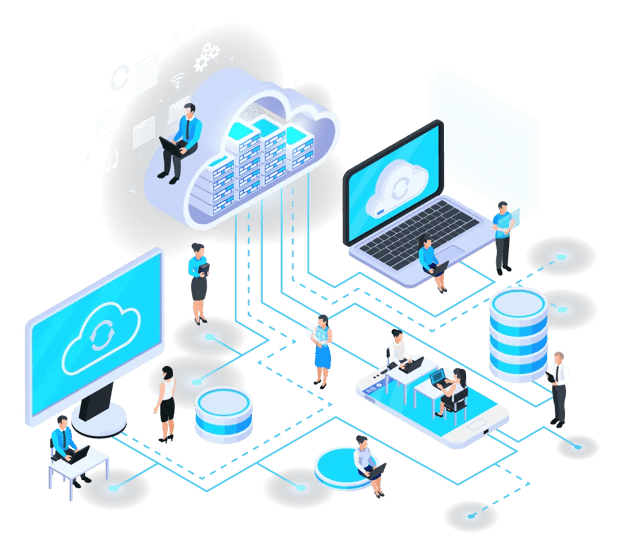In their latest forecast, Gartner writes that nearly two-thirds (66%) of application software spending will be shifted to the cloud by 2025, up from 58% in 2022. The growing demand for integration capabilities, agile work processes, and composable architecture will accelerate the shift to the cloud and drive business modernization initiatives in 2022 and beyond.
Moving your existing workloads to the cloud requires careful planning and preparation. With the right cloud migration planning, you can reduce the complexity, save time, and mitigate risks during the migration process.
In this post, we present various phases of the cloud migration journey along with a comprehensive list of activities that ensures a successful transition to the cloud.
 Phase 1: Analyze your workloads slated for migration
Phase 1: Analyze your workloads slated for migration
Evaluate your system’s cloud readiness. Your traditional IT infrastructure houses umpteen workloads from multiple vendors. Several legacy systems will be running on your data centers for decades. So, it’s crucial to assess if your system is cloud-ready. Here are a few critical questions to assess your cloud readiness:
- Is it practically possible to run your current projects on cloud infrastructure or are they restricted to running only on a local, on-premise environment?
- Does your cloud provider support the original ecosystem of your applications?
- Does your product vendor support your workloads during and post-migration in the new cloud environment?
A thorough understanding of your current system simplifies your path to a successful migration. Carefully analyze these factors before you begin your cloud journey:
Perform an in-depth analysis of your application before starting your migration process. If you have multiple applications to be migrated to the cloud, decide which applications should be moved to the cloud first.
Analyze your system’s complexity. Gather as much data as possible about your current system, like resources, capacity, memory, database, etc. This could help you make the right decisions quickly when your workloads are moved to the cloud. Determine the apps that are cloud-ready, the ones that need to be prioritized due to business needs, and the ones that are desirable, but can wait.
Identify the applications that will be affected by the migration. Find out if any of your applications require refactoring. Check for any complications that could probably arise when your system’s underlying on-premise infrastructure is migrated to the new cloud environment.
Consider application dependencies. If a particular business application has numerous dependencies, plan to migrate it to the cloud at a later phase, so your day-to-day operations aren’t impacted. Ensure the shift to the cloud happens on time to avoid any roadblocks that could slow down the entire migration process.
The best practice is to migrate those applications first that require minimal re-hosting and resources such as low storage and computing.
Phase 2: Define your cloud migration strategy and roadmap
Picking the right cloud migration strategy is crucial because it helps you categorize and plan your workloads efficiently.
Identify your migration strategy. Here are the top three migration strategies your IT can use while moving to the cloud:
- Rehost: Choose this strategy if you want to migrate your workloads to the cloud without making any changes. Leading cloud providers like AWS, Azure, and Google Cloud Platform provide native tools to support this type of migration.
- Replatform: This migration strategy is used to modernize existing applications within the current on-premise environment before migrating them to the cloud. For instance, converting an on-premise SQL database to cloud SQL or moving a VM-based app to a container-based architecture.
- Rebuild: If your legacy business application cannot be migrated to the cloud and fails to meet your growing business needs, the rebuild approach allows you to abandon the existing code and rebuild the application from scratch to fit the new cloud environment.
Here are some of the key aspects to consider after deciding on the cloud migration strategy:
Analyze the potential cloud platform and service provider. Choose a cloud service provider based on the following factors:
- Migration experience and post-migration support
- Cost-effectiveness
- Availability across multiple regions
- Resilience against failures
- Ability to innovate and differentiate
- Compliance with industry standards, data security norms, etc.
Choose the right migration tool. Though all migration tools help move your workloads safely to the cloud, each tool differs from the other in terms of functionality and architecture. To understand which migration tool works best for you, find answers to these questions:
- Does the migration tool require installing agents to migrate each application? If you have multiple applications to be moved to the cloud, it is better to choose an agentless migration tool, such as AWS Server Migration Service or Azure Migrate tool.
- Does the migration tool allow you to test applications before they are migrated, without taking your live applications or production environment offline?
- Does the tool offer analytics-based recommendations to rightly map on-premise instances to cloud instances? Or does it suggest insights to optimize performance or cost in the cloud?
- Does the tool help you track the migration progress?
- Is the tool capable of handling both data and app migration, or just data?
- What is the predicted downtime to complete the migration successfully? In the case of multi-tiered applications, will the migration tool automatically orchestrate the shutdowns and restart the systems post-migration in a specific order?
- Does the tool automatically adapt your application to match the new cloud environment? Does it maintain DNS configurations automatically?
- What happens when all your workloads, data, and systems are migrated to the cloud? Do you need to shut down any service at the source or destination to implement the changes? Do you need to uninstall or install any migration agents during the cutover? If your data is still out of sync post-migration, what is the average time taken for full-fledged recovery?
- Will it be possible to roll back your application to on-premises, if required and what’s the expected duration to perform the reversion?
Cloud migration tools are evolving tremendously over the years. It’s crucial to identify the requirements that are important to your business and then select the right migration tool.
Phase 3: Test your data and applications before the actual migration
Running a proof of concept (POC) test before officially migrating your workloads saves your time and mitigates risks. A POC allows you to evaluate how your applications will perform in the cloud and make the essential customizations before going live.
Review the cloud environment prerequisites. Ensure all the cloud environment requisites are in place to support the migrated workloads. For instance, security, networking, and other services. Also identify the managed IT services you will be buying from the cloud provider, such as DNS services, backup, and recovery, Database as a Service (DBaaS), etc.
Simulate the real world to test the performance. Running a pilot project in a simulated environment that mimics the real-world scenario will allow you to identify your cloud vendor’s capabilities and limitations. It also helps you evaluate key metrics such as your application’s resource and capacity requirements. Simulating real-world load on the system enables you to choose the right-sized instance for memory-intensive applications to run successfully in production.
Run tests to keep your cloud budgets in line. Right-sizing your cloud instance based on intelligent data recommendations is a must to optimize your costs in the cloud. Adopt a migration tool that can evaluate your system’s on-premise usage and customize instance sizes for the targeted cloud without degrading performance.
Run clones of the live production environment. Migration tools like AWS Elastic Beanstalk and Azure Automation allow you to recreate a live production environment, so you can test the migration realistically, validate the changes, and make your system safe and ready for the actual migration. Testing your applications in the cloned environment doesn’t affect your live system’s data and uptime. You can simply delete the test clone post use.
Running proof of concept (POC) tests helps validate your application’s functionality and performance, cloud costs, and migration tools and their features. A POC perfects your migration process, secures the right configurations related to security controls, firewalls, and other settings, and also helps you save deployment costs in the cloud.
Phase 4: Migrate to the cloud
Get your migration project on the success track after completing the three phases - analysis, preparation, and testing. At Srijan, we recommend using an incremental, agile approach for migrating your workloads to the cloud. Agile methodology allows you to review the results at each phase and make the necessary adjustments instantly based on end-user feedback.
Prioritize workloads for migration. Set up your applications in the cloud and configure the settings, network, security, storage, and other architecture-level factors. The next step is to move your resources to the cloud based on priority. You can probably test this during the previous POC stage to phase your migration plan.
Test new deployments thoroughly. Test the new cloud environment well, once you have migrated your workloads. The test should cover various dimensions such as performance, functionality, integration, security, and disaster recovery. Look for challenges such as database errors, server crashes, and poor performance of applications. Switch your live traffic to the new cloud system only after resolving these challenges and gaining enough confidence.
Direct user traffic to the new cloud environment. Induct your live systems and workloads to the cloud only when the new deployments fare well in terms of test results, performance, consistency, and availability. If you face any sensitive changes or a surge of issues while switching, you can always revert to the old on-premises configuration, save some time to sort out the issues and retry the migration deployment.
Phase 5: Optimize and finetune your cloud environment
Optimize based on ongoing operations. After completing the migration process, you can optimize your cloud environment based on your operational usage patterns. For instance, you can track your cloud vendor’s recent product updates and implement the changes to optimize your cloud system. Adjust and right-size your cloud instances based on real-time demand. Use governance tools and intelligent recommendation systems to report your cloud usage habits. This helps you optimize cost and performance.
Review the usage of cloud-based IT. Platforms like Amazon CloudWatch and Google Cloud Monitoring can constantly monitor your workloads to identify if any cloud services are over-utilized or under-utilized. These tools provide you with data and actionable insights to optimize resource utilization proactively and identify the instances that can be stopped to reduce billing overages.
Closing down your on-premise workloads. Retaining the on-premise environment is recommended only until you resolve the issues occurring while switching your workloads to the cloud. To get the best out of the cloud ecosystem, it is advised to decommission the old on-prem workloads and constantly optimize the new cloud environment.
Take off to the cloud with Srijan
Simply moving your legacy workloads to the cloud is not the right approach for a successful cloud transition. It’s important to develop a well-crafted migration roadmap by partnering with a trusted cloud migration services provider. At Srijan, our team of specialists can help you develop a Hybrid Cloud Operating Model that offers the best of both worlds by combining the agility, speed, and innovation of the public cloud with the robust security, control, and compliance of the private cloud.
Every cloud migration project is unique and it is not just enough to choose the right platform, you will need the right partner to accelerate your modernization journey. Srijan is a VMware Professional Solution Provider offering a wide spectrum of services, including cloud migration as well as legacy application and platform modernization.
Also Read: Powering Enterprise Cloud with VMware Tanzu
Migrate to the cloud and be on cloud nine! Talk to our expert to understand how our cloud migration services can add value to your business.
Our Services
Customer Experience Management
- Content Management
- Marketing Automation
- Mobile Application Development
- Drupal Support and Maintanence
Enterprise Modernization, Platforms & Cloud
- Modernization Strategy
- API Management & Developer Portals
- Hybrid Cloud & Cloud Native Platforms
- Site Reliability Engineering




